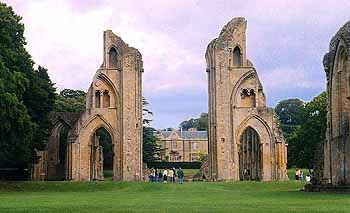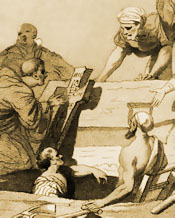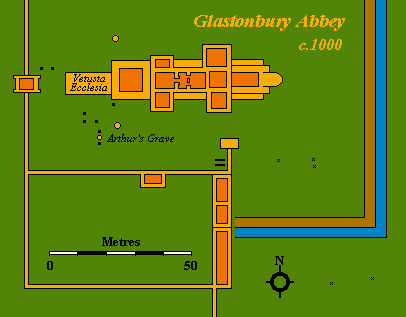 |
 |
|||
|
|
The Tradition: Early stories tell us that Arthur was taken to the Isle of Avalon to be healed of his wounds after the Battle of Camlann. Late tradition assumes that he died and was buried there, though earlier sources indicate the whereabouts of his grave to be unknown. Hence his lying under a mysterious hill waiting to return and lead his people to victory. Avalon is traditionally identified as Glastonbury and Arthur is thus assumed to have been buried at the ancient Abbey there. This was an eminently suitable spot for the last resting-place of the High-King: the most holy place in Britain, for Glastonbury's Vetusta Ecclesia or "Old Church" is said to have been founded by St. Joseph of Arimathea himself.
Possible Interpretations: Though there is no dating evidence for the Vetusta Ecclesia, it probably existed in the early Dark Ages. An Abbey of some sort is indicated at this period by an extant land grant from an early King of Dumnonia (possibly Bledric) dated to 601. Radford believed his early postholes were the remains of the cells of Dark Age monks, though this is hotly disputed. The two mausolea near the site of Arthur's supposed burial were probably the graves of revered saints or founders, marked by tapering stone crosses, the so-called pyramids of early writings. Adjoining burials would have been reserved for highly important persons, if not Kings. The large hole was, presumably, all that remained of the monks' earlier excavations. Arthur's memorial cross disappeared in the 18th century, but a 1607 engraving by Camden survives. Unfortunately this does not show any mention of Guinevere, though this could have been engraved on the reverse. Alcock identifies the lettering to be of tenth century style and suggests the cross was placed in the grave at this date when St. Dunstan had the ground level of the cemetery raised and any standing memorials removed. Similarly dated leaden crosses have been discovered associated with burials excavated at nearby Wells Cathedral.
|
|||
| © Nash Ford Publishing 2001. All Rights Reserved. | ||||





 GLASTONBURY ABBEY
GLASTONBURY ABBEY Ancient
Discoveries & Propaganda:
Unfortunately, the identification of Glastonbury with Avalon immediately
follows the miraculous events of 1190. In this year, the monks of
Glastonbury claimed to have discovered the bodies of both King Arthur and
Queen
Ancient
Discoveries & Propaganda:
Unfortunately, the identification of Glastonbury with Avalon immediately
follows the miraculous events of 1190. In this year, the monks of
Glastonbury claimed to have discovered the bodies of both King Arthur and
Queen  Modern
Archaeology: Any trace of the
wooden Vetusta Ecclesia or "Old Church" has been
completely destroyed by the crypt of the Lady Chapel, but Radford's
excavations did find the post holes of four early buildings in the ancient
cemetery area to the south. He also revealed extensive details of King
Ine's Abbey Church built to the east in 720, extensions of the 760s and
Modern
Archaeology: Any trace of the
wooden Vetusta Ecclesia or "Old Church" has been
completely destroyed by the crypt of the Lady Chapel, but Radford's
excavations did find the post holes of four early buildings in the ancient
cemetery area to the south. He also revealed extensive details of King
Ine's Abbey Church built to the east in 720, extensions of the 760s and